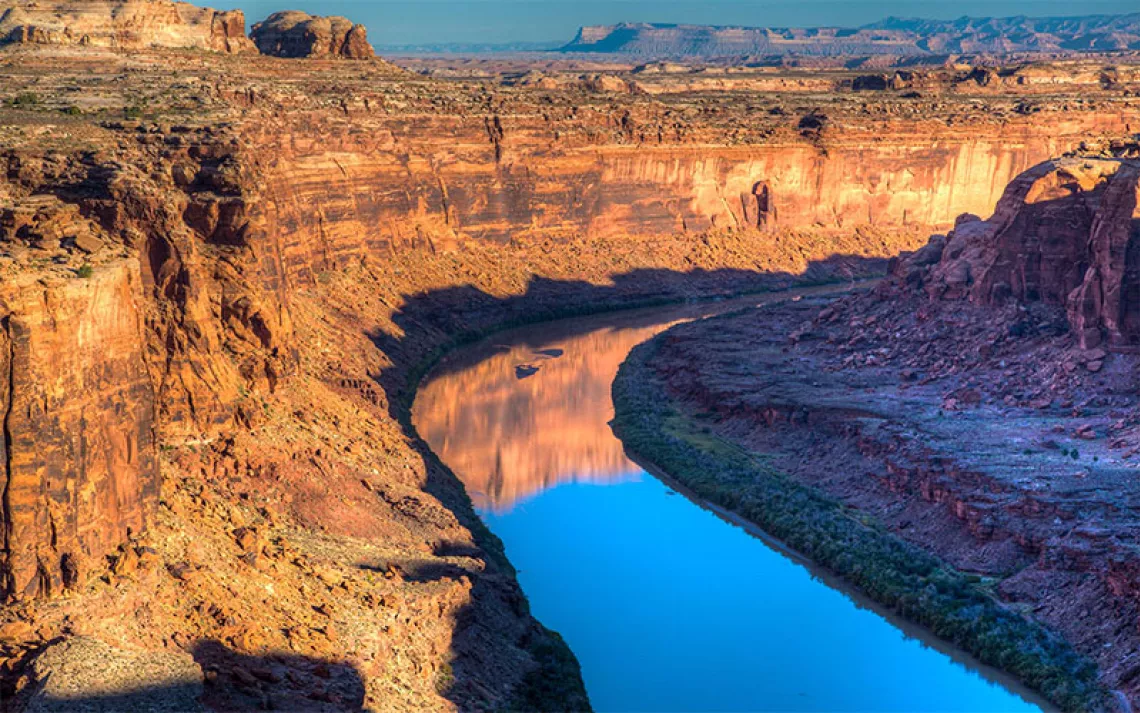The Utah Monolith Is Just the Latest Tale of Desert Trash
One Utahn’s take on the unsettling patterns behind the monoliths

The opinions expressed here are solely those of the writer and do not necessarily reflect the official position of the Sierra Club.
We still don’t know where it came from. Not precisely, anyway. Suffice it to say that the Utah monolith that made headlines this late autumn was not a sign from the heavens, nor of extraterrestrials pulling a 2001: A Space Odyssey–themed prank. The monolith’s triangular hole, not to mention the chipped rock leftover at its installation site, make clear the shiny phenom’s earthbound origins.
We don’t even know what it was meant to be. An art installation? A joke? Just something shiny to look and direct our magpie-like attention at for a few minutes in this noxious year? Who knows. But in the end, it became another piece of garbage left in the backcountry—just like some of the junk its dismantlers have left behind at other places.
If you were under a rock—presumably one far distant from southeastern Utah—here’s what happened. On November 18, biologists with Utah’s Division of Wildlife Resources, busy tracking bighorn sheep through San Juan County’s red rock desert, spotted something strange from their helicopter. It was a shiny triangle about 10 feet tall and two feet wide, cut and affixed into the ground, with a little epoxy left over.
What the point was, if any, went undisclosed as we all gawked at the images that soon wallpapered the Internet, and as some people went out to see the structure—leaving tire tracks and bathroom tissue in a place where the wandering bighorn previously went unharassed. The BLM rolled out the usual legal boilerplate—that without permission, such installations are illegal—and chastised those who blazed trails to see it. Just a week later, where the monolith once stood, there were only cut marks and chipped stone. Law enforcement said they wouldn’t look into, nor prosecute, whoever removed the prism. Soon enough, though, Utahn “adventure sportsmen” Andy Lewis and Sylvan Christensen posted a video taking credit for the teardown.

Prior to removal of the monolith, its exact location was so remote that officials, worried that people might get lost or stranded trying to find it and require rescue, did not reveal it publicly. | Courtesy of Utah Department of Public Safety via AP
The pair proclaimed their adherence to “Leave No Trace” policies, tsk tsk-ing the installation of such an eyesore in such a beautiful place. And, they got applause for it. Yet in Moab, a few hours away from the spot where the monolith once stood, locals were rolling their eyes at the hypocrisy of “Sketchy Andy.”
Back in 2016, a group of climbers dubbed the “Moab Monkeys,” including Lewis, festooned a favorite climbing spot called Ancient Art with Christmas lights and decorations. And although the stunt left behind plenty of festive garbage behind, Lewis was unrepentant. “I’m bringing style back,” he told the Moab Sun News. Apparently, that self-proclaimed style also involved harassing his critics online—the following spring, Lewis was formally charged with criminal harassment against three women who dared question his “style.” The sexually violent threats are unprintable, but the charges were later dropped after Lewis entered a “no contest” plea. The gross behavior never made news beyond Moab. In the minds of many locals, the monolith removal gave Sketchy Andy a chance to play hero to anyone who wasn’t already aware of his reputation.
The Southern Utah Wilderness Alliance did not respond to an interview request for this story, and the BLM declined to comment—only referring the author to previous statements on the monolith and BLM outdoor ethics. Perhaps we’d all like to put 2020 behind us. But the legacy of the monolith, Lewis’s hypocrisy, and the tire treads in the desert won’t vanish so readily.
It’s difficult not to be transfixed by the wild beauty of southeastern Utah. The slickrock deserts and slot canyons are places where you can lose yourself, find yourself, and get lost all over again. You would think—in a place blanketed by federal lands, national parks, and natural wonders—that everyone would practically breathe the phrase “leave no trace.”
But there is another spirit here, one of American individuality and exceptionalism. The ghost of Ed Abbey remains. This is not a place for all, but a place for scores upon scores of individuals. Rock spires are draped in Christmas lights, climbers leave holes and abandoned equipment in their wake, graffiti piles up around ancient rock art, dinosaur fossils are vandalized, and, adding further insults to ecological injury, RV encampments sprout gardens of toilet paper blossoms as visitors make their mark on the desert. To Sketchy Andy and unfortunately, many others, these places are not seen as the lands of Indigenous peoples, as places for everyone, or even as parks where there are actual rules.
Just as Abbey himself referred to everything he could see from his Arches National Park trailer as “Abbey’s Country,” it seems many in southeastern Utah are daily claiming the land under their own names for their own ends. The Utah monolith isn’t a strange exception. It’s just another piece of desert trash, a reminder of the values we have yet to truly hold dear.
 The Magazine of The Sierra Club
The Magazine of The Sierra Club



